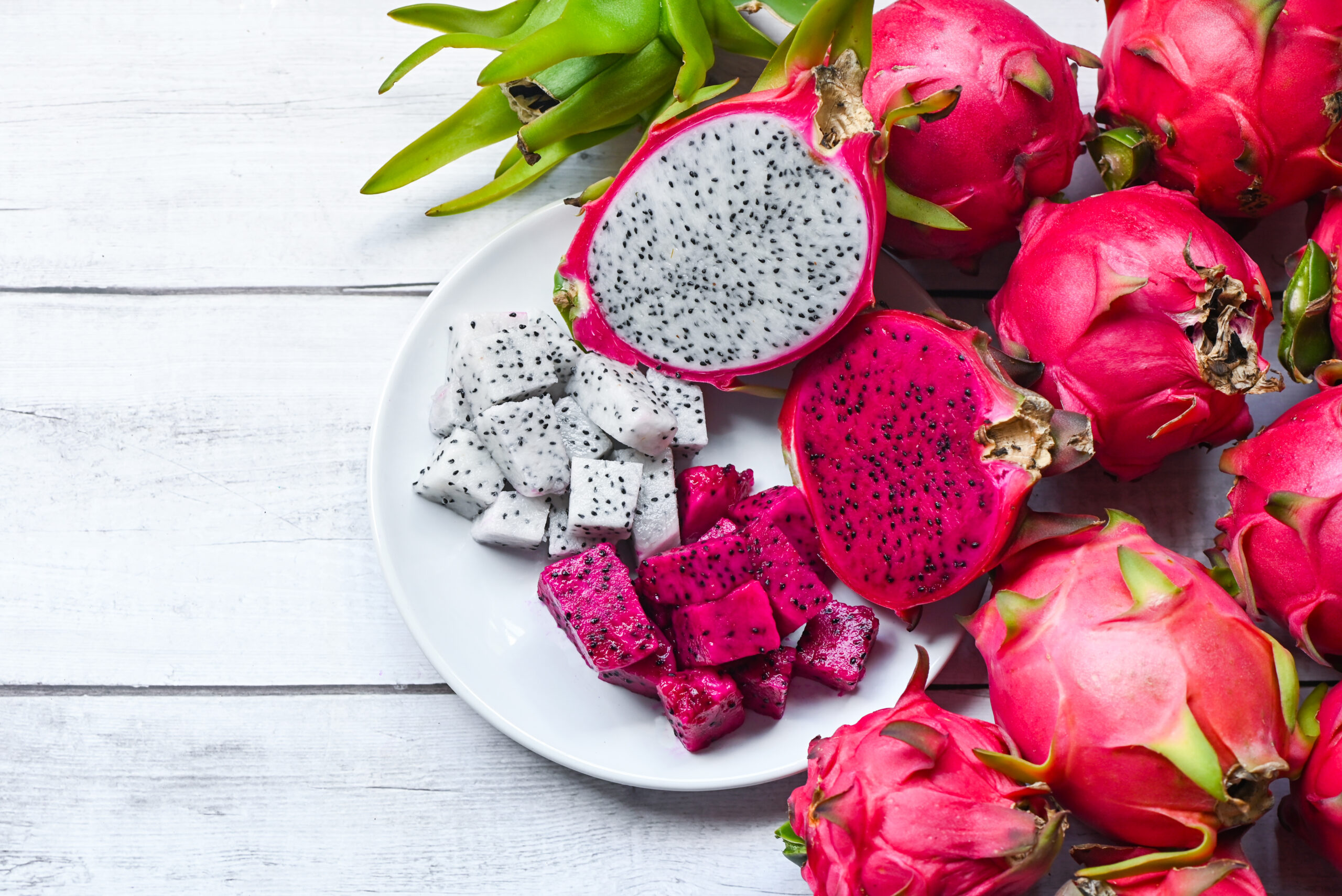Dragon fruit is a tropical fruit that has gained significant popularity in recent years for its unique appearance. The brightly coloured fruit is also known as the pitaya or pitahaya, belonging to several cactus species.
Since dragon fruit are from various species, the fruits can have different appearances. The spiked outer skin usually has a bright pink colour with leaf-like attachments, but some varieties have yellow skin. The inner flesh is often white with small black seeds dotting it. Certain varieties have dark pink flesh.
The most common varieties include:
Pitaya blanca (Hylocereus undatus) is the common version with a pink skin and white flesh.
Pitaya roja (Hylocereus megalanthus) has red or dark pink flesh.
Pitaya amarilla or yellow pitaya (Selenicereus megalanthus) has a yellow skin and white flesh.
Dragon fruit taste similar to melon as it is sweet, but bland in comparison to the bold exterior.
Among the many health benefits of dragon fruit, it contains many antioxidants that give you a glowing and younger looking skin. It contains vitamins A, B and C, as well as the minerals iron, magnesium, and calcium.
Thanks to its aesthetic appearance, people are inspired to create interesting dishes with these fruits. These include jams, jellies, smoothies, juices, sauces and even wines.

Dragon fruit are harvested by hand. You can wear gloves to protect your skin from the thorns. (Source: Vecteezy)
Climatic and soil requirements
Originally from Southern Mexico and the Pacific coasts of Guatemala, Costa Rica and El Salvador, the plant is best suited for tropical or subtropical climates and have shown great success in countries such as South Africa and Vietnam.
Climates best suited for these cacti are the same as those where macadamias, avocados, and bananas flourish. Average day temperatures should be between 21 and 29 °Celsius. In extreme weather it can tolerate temperatures in the high thirties, and up to –1 °Celsius, but it does not tolerate frost at all.
Pitaya cacti fare well in soil with good drainage and high levels of organic matter. The ideal soil acidity is between 5,5 and 7 pH.
Planting
For commercial growing, it is recommended that seedlings from trusted nurseries are used. However, cuttings can be made to propagate plants. 20 cm cuttings can be made, placed in the soil and lightly irrigated to encourage roots to sprout.
To prepare the soil bed, start by ploughing and tilling the soil. The goal is to create a fine texture that is free from weeds. Next, a trellis structure should be erected to support the heavy vining cactus.
A single pole trellis system is recommended. Plant 1,8 m high precast concrete poles. A circular frame on top assists in balancing the structure and holding the heavy heads. Each post can carry three or four plants.
The stems grow up to 4 m.
Spacing between posts can be 4 m by 2,5 m, or 5 m by 2,5 m.
It will flower twelve to fourteen months after planting.
An establishment of dragon fruit can produce to up to 30 years!

Once the flowers are pollinated, it takes 50 days for the fruit to form. Plants can flower up to six times per season. (Source: Vecteezy)
Irrigation
The cacti needs yearly rainfall between 600 to 1 300 mm. If the area in which the orchard is located receives less than 400 mm per annum, it is recommended that irrigation systems are set up.
Pollination and harvesting
The plant blooms at night and mostly rely on nocturnal pollinators, but in commercial production in Southern Africa, growers use bees as well. Flowers usually open at 18:00 and close again at 11:00. Because of this, the flower is known as a “lady of the night” or a “moonflower”.
Cross-pollination encourages fruit set, so it is recommended that more than one cultivar is planted.
A grower can expect the plant to flower between three and six times per season.
Fruit matures 50 days after pollination and once harvested, has a shelf life of 40 days. Dragon fruit also can have a long fruiting season of almost six months if managed well.
Fruits are harvested by hand once the colour starts to grow deep.
Fertilisation
In its vegetative state, the plant can be fertilised with a mixture of muriate of potash, super phosphate and urea in the ratio of 40:90:70 g per plant. Increase this amount yearly with 20 g as the plant grows larger.
Pest and diseases
Animals such as monkeys, birds and livestock eat both the leaves and fruits. In areas where the animals damage the orchards, shade netting can be constructed to keep them out.
Other pests include mites, thrips, ants, scale insects, mealy bugs, beetles, slugs, borers, nematodes, fruit flies and rodents.

The interesting appearance of the dragon fruit inspires interesting food creations. (Source: Pixabay)
Dragon fruit is susceptible to the following diseases:
- Stem rot
- Anthracnose (causing red-brown lesions)
- Fusarium spp
- Aspergillus spp
Sources:
Bohol, E. (2023) Dragon fruit harvest and storage, Wikifarmer. Available at: https://wikifarmer.com/dragon-fruit-harvest-and-storage/.
Jagdish, A. (2018) Dragon Fruit Cultivation Information Guide, Agri Farming. Available at: https://www.agrifarming.in/dragon-fruit-cultivation.
Louw, M. (2023) Dragon fruit farming, South Africa Online. Available at: https://southafrica.co.za/dragon-fruit-farming.html.









